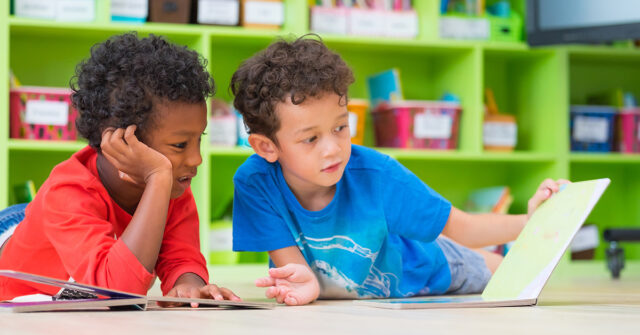Reading Workshop 2.0: Some preliminary thoughts as I begin writing a manuscript for Heinemann about teaching reading in the digital age
Reading Workshop 2.0: Some preliminary thoughts as I begin writing a manuscript for Heinemann about teaching reading in the digital age
[An earlier version of post was published on Monday, March 17, 2014, on Frank Serafini’s blog.]
I have been reading and writing about workshop approaches to reading instruction for the past twenty-five years. You might think I would have run out of things to say about these instructional approaches and classroom frameworks a long time ago. Alas, not true. A number of changes in literacy education, in particular regarding technology and digital resources, have affected the ways we teach children to read and write and how we organize classrooms to support this endeavor. Drawing on my previous work on the reading workshop (Serafini 2001, 2008), my new book, Reading Workshop 2.0 [Two-Point-Oh], will offer teachers and literacy educators new resources for instruction, discussion, and text analysis and some new ways to think about supporting students in their journey toward becoming more engaged literate beings.
For many teachers reading workshop 2.0 may seem an unwelcome addition to an already overcrowded curriculum, just another thing to cover. However, that is not my intention. The last thing I want to do is give teachers one more thing to worry about. The resources and instructional approaches offered in this book won’t add new burdens to our workload; instead, they will help us do the same important things reading workshop teachers have been doing for years, but in more effective, efficient, and exciting ways.
The term technology can be misleading. Too often, people mean the newest gizmo or digital device being touted by friends in and out of education. However, we need to remember that the pen and pencil were also important technological advancements at one time in history; so was the codex, nowadays more commonly referred to as a book. Writing a book like this requires attending to all forms of technology, not just the newest digital resource or fad.
Lankshear and Knobel (2006) contend that in addition to addressing the new technical stuff, reading workshop 2.0 must also take into account the new ethos stuff. These terms suggest that along with the changes in technologies in and out of school, the ways these technologies are used and how they alter our interaction with information, people, and ideas have also changed. As we as students and teachers draw on these new technologies (new technical stuff), we are no longer viewed simply as consumers of information; we are also producers and critics of information. The opening chapters will discuss these technical and ethical concepts.
Creating New Spaces
In 2001, when I wrote my first book for Heinemann, The Reading Workshop: Creating Space for Readers, the concept of space in the subtitle was primarily physical space—the organization, layout, and procedures necessary for implementing a reading workshop. The expansion of the Internet and the increased availability of new digital resources since I wrote that book necessitate that the space conceptualized in this new book has both physical and virtual aspects. Creating space for readers and reading in a 2.0 environment means addressing the role of digital and on-line resources in addition to the traditional resources of classroom libraries, printed texts, and word processors. I see these new resources and approaches as expansions of our traditional spaces, moving the learning that occurs there beyond the walls of the traditional classroom.
As more and more books are offered in digital formats, as book reviews are posted on-line for anyone in the world to read, and as students’ access to information and communication technologies (ICTs) continually expands, we must take these resources and their exciting possibilities into account. What counts as being literate is growing more complex every year. Because ICTs and digital resources require different skills from the skills needed by our parents’ generation, decoding printed texts needs to be viewed as a necessary but insufficient set of skills given the complexity of multimodal texts, on-line and digital resources, and social media (Luke and Freebody 1990). Reading has always been more than decoding; it’s just more obvious in these new environments that students will need a larger array of skills to be successful readers.
Reading as Interpretation, Writing as Representation
The strategies, processes, and practices used for making sense of the more complex texts (multimodal ensembles) encountered in today’s world goes beyond simple notions of comprehension to more complex conceptions of interpretation. In similar fashion, writing is no longer simply putting pencil to paper; it is about designing multimodal texts by drawing on digital resources, visual images, design elements, and similar resources in the process of making one’s ideas and interpretations visible to the entire world (almost instantaneously) through the Internet and other ICTs. This changes everything. What knowledge is valued, what processes and practices are used in coming to know, and whose knowledge is valued and privileged change with the new technical and ethos stuff.
Design is thinking made visible, and our students need to learn new ways and use new tools for making their thinking visible. This is one of the basic concepts I’ll be exploring. How do students use new digital, on-line, and visual resources to make their ideas visible and available for further discussion?
References
Freebody, P., and A. Luke. 1990. “Literacies Programs: Debates and Demands in Cultural Context.” Prospect: Australian Journal of TESOL 5(7), 7–16.
Lankshear, C., and M. Knobel. 2006. New Literacies: Everyday Practices and Classroom Learning. 2d ed. Maidenhead, Berkshire UK: Open University Press.
Serafini, Frank. 2001. The Reading Workshop: Creating Space for Readers. Portsmouth, NH: Heinemann.
Serafini, F., and S. Youngs. 2008. More (Advanced) Lessons in Comprehension. Portsmouth, NH: Heinemann.



